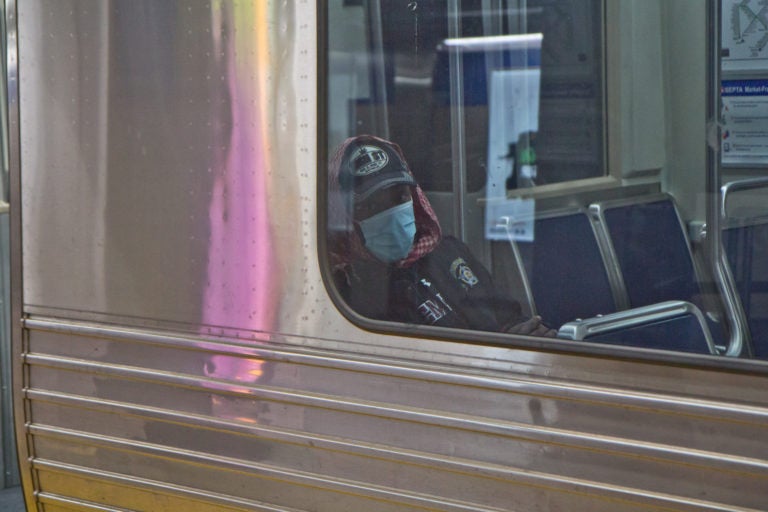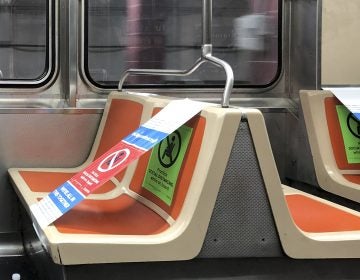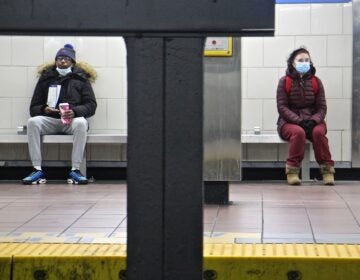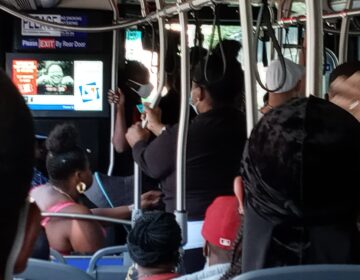SEPTA faces a ridership problem that coming federal aid won’t fix, experts say
SEPTA and other regional transit agencies are facing an unprecedented challenge that won’t be solved by a $25 billion relief package advancing on Capitol Hill.

A SEPTA rider dons a surgical mask. (Kimberly Paynter/WHYY)
SEPTA is a step closer to a federal bailout after a week that saw catastrophic ridership drops and financial strain related to the COVID-19 quarantine.
The virtual certainty that a $2 trillion bipartisan COVID-19 stimulus bill would clear the U.S. Congress was welcome news for the transit agency. The stimulus package includes $114 billion for transportation, with $25 billion earmarked for transit agencies nationwide.
“SEPTA is extremely grateful to Senators Casey and Toomey and the entire Pennsylvania Congressional delegation for their tireless efforts to reach a bipartisan agreement on a federal coronavirus assistance package,” said SEPTA Chairman Pasquale T. Deon Sr. “The critical emergency relief in this bill will help SEPTA sustain operations through the COVID-19 crisis.”
Just last week, SEPTA had faced an unprecedented 64% systemwide dip in ridership and a projected $150 million shortfall for the fiscal year from diminished farebox collections. In hopes of staunching a financial bleed, the transit agency had enacted snap cost-cutting measures that include executive pay cuts, a hiring freeze and elimination of overtime.
“Ridership is going to struggle for a while,” said Fran Kelly, assistant general manager for SEPTA. “We don’t know how long this is going to last.”
Other regional transit agencies face a similar pinch.
John Hanson, CEO of Delaware River Port Authority, which operates the PATCO subway line, said that the system faces “probably in excess of $100 million in lost revenues and the expense also associated with the COVID-19 effort.” He estimated ridership on the subway line was off by 90% with a 45% drop in traffic on the four bridges DRPA also administers.
“DRPA and PATCO are in very good financial positions,” Hanson said. “But in order to continue to support the economy, the people of the region in the long term, that’s when we’re going to need the help.”
SEPTA spokesperson Andrew Busch expressed confidence that the federal relief should help “cover the $150 million operating shortfall.”
But the agency is already facing a string of big-budget repair and equipment replacement projects in the coming decades. The question now may be how long the COVID-19 shutdown persists, when riders feel comfortable returning to mass transit and if the historic stimulus package will even be enough to cover the gap.
“No industry, company, or organization is being spared from the devastating public health and economic consequences of this crisis,” said Greg Krykewycz, associate director of multimodal planning at the Delaware Valley Regional Planning Commission. “There was a challenge for [SEPTA] ridership before COVID-19. But now that will be compounded.”
The planner said the federal relief could “keep the agency whole” in the short-term, but the collateral impacts of the shutdown could shadow SEPTA for much longer. The system was already struggling to reverse ridership declines in the face of competition from ride-hailing options like Uber and Lyft and other cultural shifts such as changing commute patterns and the rise of telework. When the coronavirus shutdown ends and people begin leaving home again, their routines could be permanently altered, with more people choosing to work from home or avoid crowded transit.
“People will be out of their habits,” Krykewycz said.
And while SEPTA has faced funding crises and ridership drops in the past, few presented as sharp and all-encompassing a decline as COVID-19.
A $6.5 billion backlog in capital budget projects last brought the agency to the brink of fiscal crisis. Then, officials threatened to enact a “doomsday” service plan –– eliminating nine rail lines, cutting trolley service, and ending Broad Street Line express trains –– to divert dollars to critical repair projects. That emergency was similarly staved off by the passage of a state transit funding bill.
The agency saw near 50% declines in rail ridership after its ill-fated takeover of the region’s legacy rail routes and a protracted labor strike in the 1980s, and another big drop after a prolonged maintenance project in the 1990s. In both instances, ridership took years to recover.
“There will be a lag,” Krykewycz said. “Transit agencies will be expected to provide the same level of service as they did before the crisis, but ridership will take longer to come back.”
But Joe Coccio, secretary-treasurer with the Transport Workers Union Local 234, which represents most of SEPTA’s drivers and other blue-collar workers, said there was little precedent for the agency’s current situation.
“I have 37 years on the job and have never seen anything like this,” he said. “I’m proud to say though, our attendance has remained steady, and our people are coming to work and risking their health, as well as their families, to provide clean, safe, reliable equipment.”
PlanPhilly’s Ariella Cohen contributed reporting.
WHYY is your source for fact-based, in-depth journalism and information. As a nonprofit organization, we rely on financial support from readers like you. Please give today.




![CoronavirusPandemic_1024x512[1]](https://whyy.org/wp-content/uploads/2020/03/CoronavirusPandemic_1024x5121-300x150.jpg)




